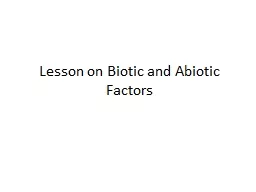

What factors both living and non living will affect my life 3 minutes To THINK PAIR SHARE Factors affecting mouse Predators Food Shelter Temperature Weather Competitors Pathogens Parasites ID: 715970
Download Presentation The PPT/PDF document "Lesson on Biotic and Abiotic Factors" is the property of its rightful owner. Permission is granted to download and print the materials on this web site for personal, non-commercial use only, and to display it on your personal computer provided you do not modify the materials and that you retain all copyright notices contained in the materials. By downloading content from our website, you accept the terms of this agreement.
Slide1
Lesson on Biotic and Abiotic FactorsSlide2
What factors both living and non living will affect my life?
3 minutes To
THINK PAIR SHARESlide3
Factors affecting mouse
Predators
FoodShelterTemperatureWeatherCompetitors
PathogensParasitesClean WaterSlide4
Would the same factors affect this flower?Slide5
Factors Affecting Plant
Predators
FoodShelterTemperatureWeatherCompetitors
PollinatorsSoilNutrientsWindAspectDaylightSlide6
Keywords for today
Biotic
AbioticClimaticEdaphicSlide7
At the end of today’s lesson you will be able to
Define biotic, abiotic, climatic and edaphic
Give examples of each type of factorSlide8
Classify the factors in the picture as either biotic factors or abiotic
factorsSlide9
List the Biotic and Abiotic Factors in the ImageSlide10
Decide if Factor is Biotic or Abiotic
Write A if Abiotic
_______ Mouse
_______ Rocks _______ Water _______ Fish _______ Paper
_______ Glass
_______ Aluminum
_______ Wooden Ruler
_______ Sand
_______ Clouds
Write B if Biotic
_______
Corpse
_______ Snail
_______ Vegetation
_______ Bread
Mould
_______ Trees
_______ Soil
_______ Plastic
_______ Pipe
_______ Air
_______ WindSlide11
Biotic or Abiotic or Both?
Fish
Chair
Water
Train
Atom
Plastic
Insects
Wood
Sea Shell
Dirt
Dog
Worm
Burger
Wheat
T.V.
Broccoli
Pine Tree
Energy
Flower
Dead animal
Wooden Table
Cotton Shirt
Sunlight
Ice
Hydrogen
Strawberries
WindSlide12
Decide whether these items are Abiotic, Biotic, or can be argued to be both, then
place in
the Venn diagram.
Abiotic
BioticSlide13
List the Biotic and Abiotic Factors in the ImageSlide14
Abiotic Factors
Climatic and Edaphic
Climatic - factors that relate to the weatherEdaphic – factors that relate to the soilSlide15
What climatic factors could we measure?
Light Intensity
HumidityWind speedTemperatureAspect
SlopeSlide16
What edaphic factors could we measure?
Soil pH
Amount of water in soilSoil TemperatureSoil AirSoil TextureSlide17
Inquiry Approach
Do humans always adversely affect biodiversity?
Rice fields versus Marsh
Is the weather in Ireland the same?climatedata.euSlide18
The Deer Population
A
field study was conducted to observe a deer population in a given region over time.
The deer were counted at different intervals over a period of 40 years. During this period of
time both
ranching and hunting increased in the study region.
A
summary of the data is presented
in the table.Slide19
Questions on Deer Population
During which 10 year period did the greatest increase in the deer population occur?
State one possible action that could have been used to help maintain a more stable population of deer in the area.
Identify an abiotic limiting factor for the deer populations.Identify a biotic limiting factor for the deer populations.List two problems an overpopulation of deer can cause in the environment.Slide20
Abiotic FactorsSlide21
Biotic Factors